Geoscience Reference
In-Depth Information
gradient is at a maximum. This effect of different
pressure thicknesses explains the increase in the
speed of the basic mid-latitude westerlies with
height. In the simple case of thicknesses decreasing
uniformly with latitude at all levels, the wind shear
would be only in terms of speed, with no change
in direction with height. The pressure height
contours would in turn parallel contours of
thickness.
This is but a simplification, however. It is often
observed that clouds at different levels move in
different directions. This is evidence that there
can be vertical wind shear not just in terms of
speed, but in direction as well. This important
relationship is illustrated in
Figure 7.6
. The
diagram shows hypothetical contours of the 1000
and 500mb pressure surfaces and of the 1000 to
500mb thickness. Unlike the simple case outlined
in the preceding paragraph, the geostrophic wind
at the two levels blows in different directions,
towards the upper right at 1000mb and from left
to right at 500hPa. The height contours at 500mb
also intersect the contours of 1000 to 500mb
thickness. The theoretical wind vector (
V
T
)
blowing parallel to the thickness lines, with a
velocity proportional to their gradient, is termed
the
thermal wind
. Facing downwind, the thermal
wind blows with cold air (low thickness) to the left
in the Northern Hemisphere. The geostrophic
wind velocity at 500mb (
G
500
) turns out to be the
vector sum of the 1000mb geostrophic wind
(
G
1000
) and the thermal wind (
V
T
), as shown in
Figure 7.6
. For the simpler case in which the
directions of the 1000mb and 500mb geostrophic
winds are the same, the thermal wind is simply
proportional to the difference in geostrophic speed
between the two levels. Setting the stage for further
discussion in Chapter 9, situations with directional
shear can be associated with the growth of
disturbances in the basic mid-latitude westerly
flow, seen at the surface as traveling cyclones and
anticyclones, and at upper levels as atmospheric
shortwaves. Recall that these shortwaves tend to
move through the long Rossby waves.
Contours of 1000mb surface
0
60
120
180
5640
Contours of
500mb
surface
5750
V
T
G
1000
G
500
5760
5700
5640
5580
5520
1000-500mb thickness
Figure 7.6
Schematic map of superimposed contours of isobaric height and thickness of the
1000-500mb layer (in meters). G
1000
is the geostrophic velocity at 1000mb, G
500
that at 500mb, V
T
is the
resultant 'thermal wind' blowing parallel to the thickness lines.










